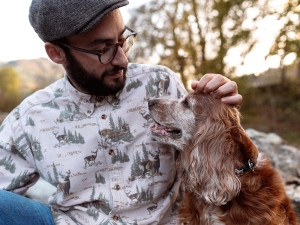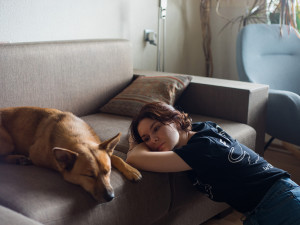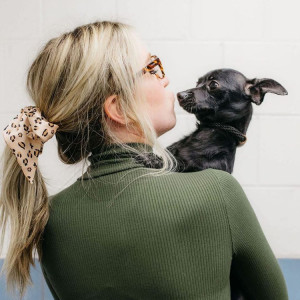6 Ways to Help Local Shelters Without Committing to Full-Time Pet Parenthood
Adoption isn’t for everyone—here are other ways you can be there for animals in need.

Share Article
Adopting a pet definitely goes on the list of “Things You Shouldn’t Do Lightly.” Once you bring that dog or cat home from the rescue, you’ve got to, you know, feed, water, and spend actual time with them. If the full-time commitment isn’t for you, here’s a thought: You can still help pets in need without going all-in as their parent.
Most animal shelters and rescue organizations are underfunded and short-staffed, and they can use all the support they can get. From volunteering in person (think: walking dogs, cuddling cats) to volunteering your skills (photography, graphic design), there’s a niche for everyone. Here are six of the many ways in which you can help the six to eight million homeless pets who pass through the shelter system each year in the U.S.

Get (totally free) deals for food, treats, accessories, tech, and way more pet parenting must-haves.
opens in a new tabFoster
Maybe you’re not quite ready for the long-term commitment of adopting a new family member, but that urge to get a cat or dog fix is strong, and there’s no reason to fight it. Fostering delivers on the rewards of being a pet parent, without (most of) the downsides — you’ll still need to scoop or pick up poop, but only for a few weeks.
Many foster pups and kitties have never lived in a normal home, so foster moms and dads are often the first person to show that animal love and earn their trust. There is arguably nothing more rewarding than watching a feral kitten take a treat from a human’s hand (yours!) or a fearful puppy wag their tail for the first time (you did that!).
The foster gig is to show a rescue animal how to be a family pet, which will get them adopted far faster than if they were cowering in the corner of a cage at a shelter. After all, you’ll have insight into the dog or cat’s personality, likes, and dislikes that a shelter worker doesn’t — not to mention tons of derpy photos. Most organizations provide foster parents with the necessary supplies, and anything else you purchase is a tax write-offopens in a new tab.
The main reason why people hesitate to foster an animal is the self-limiting belief that it will be too emotionally taxing. We feel you — but while letting a foster pet go to their adoptive home can be bittersweet, knowing that you made that happen by showing them how to dog or cat feels pretty darn good. Plus, not only does that mean you can bring a new foster pet home who needs you now, it also opens up space at the shelter so they can take in new strays off the street.
Volunteer at a shelter
Maybe fostering isn’t your thing because your landlord doesn’t allow pets, or you just know you’ll end up keeping all 12 kittens from that litter you bottle-fed. Volunteering at your local shelter may be the next best thing. At many overcrowded sheltersopens in a new tab, volunteers help pups get that long walk they need, with time to sniff and play and connect with a person before heading back inside. Cats don’t need walks, but they still need affection and socialization. So, if you’re a cat person, head to your local shelter and go cage by cage doling out kitty cuddles.
Rescue organizations also rely on volunteers to handle (read: show off) animals at adoption events and talk to prospective adopters. But if you’re more the behind-the-scenes type, ask your local shelter how else you can help — perhaps their adoption space needs a fresh coat of paint to make it more inviting? If you’re not afraid to roll up your sleeves, your local shelter will surely find something for you to help with.
Volunteer your skills
Don’t dismiss volunteering if you don’t have animal-handling experience. Great photographsopens in a new tab are essential for getting a pet adopted, so whether you’re a professional or amateur photographer, capturing those puppy-dog eyes or kittenish curiosity will help grab the attention of prospective adopters.
Organizations also need help writing grants, designing flyers, planning events, and keeping their social media feeds fresh. Do you have a strong Instagram or TikTok following or know how to write shareable posts? Maybe you’re looking to dust off your graphic design degree by creating catchy adoption promotion materials? After all, graphic design is your passion — and not just an overused memeopens in a new tab.
Transport
There are a lot of moving parts in animal rescue — literally. If you own a car, you can drive shelter animals to/from the veterinarian, saving staff valuable time. Some shelters organize free or low-cost spay/neuter clinics for people in underserved communities, but not everyone has the time or transportation to get their pets to appointments. You can help volunteer to give dogs or cats rides to their spay or neuter appointments.
If you live in the Northeast, many shelters “pull” animals from shelters in the South or the Caribbean and bring them to your region. These dogs and cats often arrive on chartered flights, and organizations need volunteers to transport them from the airport to shelters or foster homes.
Donate
Meryl Streep sang about this one in Mamma Mia: “money, money, money.” That’s what rescues and shelters need most. Organize a pet-food drive at work or at your kid’s school to help keep your local shelter’s pet food pantry stocked, drop off those threadbare towels and blankets, search for the best toys to keep shelter cats and dogs entertained during their stay, or put together a puppy or kitten “shower” to collect all of the supplies on your local shelter’s wish list. Create a Facebook fundraiser or see if your workplace has a matching gift programopens in a new tab to match your monetary donation.
Advocate
Many of the reasons why animals end up in shelters are connected to the struggles of families in your community. Consider partnering with a local shelter to create a fund to cover pet security deposits or a program that provides temporary fostering of pets while a pet parent is in the hospital. Offer to run a community pet food event, distributing food and supplies to pet parents who can’t easily get to the shelter for help.
If you’re at the bottom of this story, it’s clear that you actually want to take action to help the pets in your community — even if you can’t commit to parenthood right now. That’s huge. Take an inventory of your interests and skills, figure out the time commitment you can offer, and then let the creative juices flow. Just try not to keep all 12 of those kittens.

Lindsay Hamrick, CPDT-KA
Lindsay Hamrick lives in New Hampshire with her three dogs, chickens, and an assortment of rotating foster animals. She forces her elderly chihuahua, Grandma Baguette, on overnight backpacking trips, can diaper a lamb with one hand, and while she’s a long-time Certified Professional Dog Trainer, 66.7% of her dogs still won’t lay down when asked.
Related articles
![A brunette woman holding a spotted gray kitten up to her face while its front paws rest on her chin]() opens in a new tab
opens in a new tab10 Foster-Fail Stories That Will Tempt You to Do the Same
Adopting a foster pet doesn’t isn’t always the right choice. But for these families, it turned out to be the only one.
![Three doodles sitting outside in the grass.]() opens in a new tab
opens in a new tabHow The Animal Pad Rescued 111 Doodles From a Backyard Breeder
Further proof that you can — and should — adopt rescued designer dogs.
![shelter kittens playing with a round blue plastic toy with balls]() opens in a new tab
opens in a new tabShelter Pets Deserve Christmas Gifts, Too
Seriously, you can donate to shelters just by shopping!
![My Pit Bull is Family]() opens in a new tab
opens in a new tab“My Pit Bull is Family” Fights For the Big Little Guys
The fair-housing org’s journey from bumper stickers to databases.
![]() opens in a new tab
opens in a new tabYou Can Help Save Pups From Asia’s Dog Meat Trade
From adopting to fostering to sponsoring on Patreon, there are many ways to give these rescue organizations the support they need.
![]() opens in a new tab
opens in a new tabA Guide to Fostering Pets When You Have Kids
Advice from parents who truly do it all.
![A woman in a bright yellow-orange sweater holding a striped kitten in one hand and a credit card in the other while using her laptop in front of her]() opens in a new tab
opens in a new tabHow to Get Help With Vet Bills for Dogs Who Need Surgery
Worried about the cost of making your pet feel better? Help is on the way.
![A woman wearing a cat cartoon face mask and a pink sweatshirt holding a white kitten with spots that is looking directly at the camera]() opens in a new tab
opens in a new tab26 Pet Charities to Donate to This Giving Tuesday
A way to pay it forward to our furry friends.













